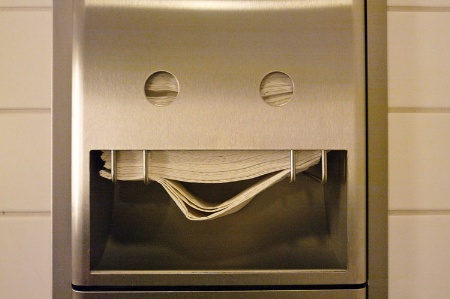The men’s has about 50 stalls: Gareth Malone could run a choir in there, if only it could be heard against the continuous blast of the Dyson hand-dryers
As the days and hours counted down before today’s publication of the results of the research excellence framework, it is likely that university toilets were in particularly heavy use. But, for the more reflective among us, the jakes provide the perfect location to reflect on what has happened to anglophone higher education over the past few decades.
Just as a country’s jails are reputedly a good place to look if you want to assess its true nature, lavatory provision, although not providing a perfect analogy, tells you a lot about the changing culture of universities.
My career of 40 years (four life sentences and eight doctorates, as I like to reckon it) has largely been passed in three institutions: the University of Edinburgh, University College London and the California Institute of Technology. I have deposited my bodily droppings at all three in quantities I tremble to visualise.
At Edinburgh, in the 1960s, traditional, Scottish, democratic traditions ran strong. The first question I was asked at my interview was, “John Andrew Sutherland – a Scottish name?” “Och aye!” I brogueishly answered (in my head). The building in which I was proudly installed was the spanking new David Hume Tower. It embodied, in its stark lines, scepticism: Humeian open-mindedness. The offices offered breathtaking picture-window views to the Pentland Hills on one side and Arthur’s Seat on the other.
It was the era of post-Robbins expansiveness and boundless optimism about universities – particularly the humanities. There was a huge intake of new blood; the advertisement I answered was for five new junior positions in the English department. The average age of those in the “assistant lecturer” grade in Edinburgh’s arts faculty was only a year or two ahead of the average graduation age. Consequently, staff and students partied together and urinated together.
I can remember being shoulder to shoulder in the communal facilities with the future Labour Party politician Robin Cook (my PhD student for a while). Who knows, perhaps a young Gordon Brown was also unzipping in the background. Staff joked about the nightmare (yes, it happened to me) of taking a dump while students, communing over the Shanks porcelain, did a verbal dump on the lecture you’d just given. Wretched.
When I moved onwards and upwards to UCL in the early 1970s, it was, as regards one’s private functions, a different world. I was given a key. It locked my office door (unnecessary, because walk-in theft was then virtually non-existent). It also let me into the departmental office and the restroom.
That restroom was rank-exclusive. Staff only. One would quite likely find oneself in a comradely piddle with the head of department – male for the past 130 years. Students had to go outside the department to find a lavatory. But, what the hell, what did they know about benign prostate enlargement? And the lazy buggers hardly ever turned up in those days anyway. They were “reading” English, not clocking in like Cowley car workers.
The median age of the junior and middle ranks of the teaching force was creeping up. One was, horrible to think, in a “parental” rather than “older sibling” relationship with the keyless student body. Privacy was more valued.

But the winds were blowing and changing. As egalitarianism took hold in the turbulent 1970s, the communal key disappeared, the jakes’ doors were thrown open (metaphorically) and – given the tininess of the facilities – queues developed, particularly for the Ladies. Embarrassment all round as lectures ended. Legs were crossed until the rush subsided.
The mood had changed too. Individual keys were now vital for office security. Theft had become common – handbags and briefcases were at particular risk. And single-sheet dispensers were installed in toilet cubicles because of the student habit of stealing toilet rolls. It was also noticeable that, as new structural shapes emerged out of the fog of reform, the upper echelons retreated into their own compounds, complete with executive bathrooms.
After the millennium, cleaning became a priority, given the ever heavier volumes the facilities had to deal with. Student numbers doubled and trebled faster than the plant could expand. And, when fees came along, undergraduates more often felt the need to attend campus. They wanted their money’s worth. So UCL closed the little “conveniences” scattered around the college and replaced them with two vast central lavatories. The men’s has about 50 stalls: Gareth Malone could run a choir in there, if only it could be heard against the continuous blast of the Dyson hand-dryers.
This general provision was, and is, sanitary and efficient: cleaning occurs every hour. But it was hard on the legs and the bladder. The men’s urinoir was a good 200 yards’ walk from the senior common room. Ditto the library (bogless for readers).
Caltech, where I spent 10 years full-time and 15 part-time, was more interested in looking God in the face through very large array telescopes than putting the texts of Jane Austen under the microscope. But it had a niche for the arts, and housed them in the finely appointed Dabney Hall of the Humanities.
The hall’s state-of-the-sanitary-art restrooms are open to all ranks, from provosts to Mexican groundspeople, and are more intelligent than some of their users (I’m thinking of myself). There is no sharing, and the area is criss-crossed with alert rays so you don’t have to touch anything. If you go in, the lights go on automatically and the door locks automatically. Flushing is automatic. Water gushes automatically from taps at optimum temperature. The last time I was there someone told me that they were installing waterless urinary stalls. Sand based: the future in parched California.
There are discreet disabled facilities too, from which you could probably phone the Moon in an emergency.
Until the 1970s there were no female staff or students on Caltech’s beautiful campus. One of the many feeble reasons trotted out, old hands recall, was that the great telescopes on mountains had no female restrooms. One female astronomer was reported, apocryphally, as saying: “Dammit, I’ll piss in the bushes if they let me have a look through the Palomar lens.”
You are unlikely ever to hear a more eloquent encapsulation of the importance of fair treatment for the nether regions even among those in full pursuit of the life of the mind.
Register to continue
Why register?
- Registration is free and only takes a moment
- Once registered, you can read 3 articles a month
- Sign up for our newsletter
Subscribe
Or subscribe for unlimited access to:
- Unlimited access to news, views, insights & reviews
- Digital editions
- Digital access to THE’s university and college rankings analysis
Already registered or a current subscriber? Login

